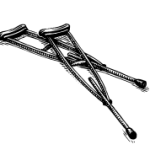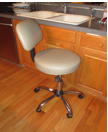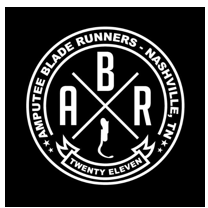First week after surgery or broken leg
The first week is hell. I was always in massive pain after the nerve blocks wore off. Every time I had to lift my leg off the four pillows and get up to get onto the crutches, the pain just about knocked me to the floor. I recommend taking advantage of being waited on that first week or two. Keep on top of your pain medication, remain lying down with your leg elevated, and sleep as much as you can.
10 days–3 weeks
Staying positive while recovering
At this point, you are probably in a fiberglass cast and off pain medication. Make friends with your crutches. I can’t stress this enough. If you sit on the couch 24/7 expecting to be waited on and entertained, it will be a long and depressing road to recovery. Believe me, I know how difficult doing even simple things will be. I’ve been there six times. Over the years, the number one complaint I have heard from people in person or online was, “I broke my ankle once. It was a horrible experience. I was couched for six week and couldn’t do a thing. My family got so sick of waiting on me hand and foot”. Some even reported it destroying marriages and relationships. Yes, you will need help, but you are not completely helpless and don’t need to become a shut-in.
Find ways to get out daily:
- When I found myself getting depressed, I forced myself out of the house. It made a huge difference.
- Find someone to go out to lunch with.
- Accompany a spouse or friend to grocery stores or places such as Target. They all have electric scooters. I was lucky it was my left leg so that I could drive myself.
- Taking a plastic shopping bag and crutching to the curb to pick up the mail can make a huge difference in your day.
- There were days that I drove though fast food restaurants just to get out of the house.
- If the weather permits, get outside and crutch around a bit. In addition to helping you emotionally, having the leg down and swinging around helps your blood circulation.
Find ways to help
I felt best when I was a part of life. In my case, I felt best when I could participate in the family chores. You know, do my part in the family. Before the ankle injury, I manicured the yard, and I did all the maintenance on the house, inside and out. The house and yard were all taken care of, as well as all the “guy jobs”. My wife never gave them a thought. In the marriage plan, I took on cooking the meals. We both cared for our children, but I went to work each day. Suddenly, I am on crutches and facing surgery that will keep me on crutches for months. Overnight, my wife is doing jobs and responsibilities that she never even knew existed in addition to cooking meals and caring for me. Knowing this just made things more emotionally difficult, and I needed to find ways to do my part.
Brainstorm all the household jobs that don’t involve walking or standing. Then, take them on. Your family will then be better equipped to take on all the jobs that you physically can’t do.
Household jobs that can be done with a bum leg:
Pay the household bills.
- Fold laundry: This can be done while sitting with your leg up. I also balanced on one leg to put clothes in the wash and transfer them to the dryer.
- Plenty of kitchen duties can be done while sitting on a high bench.
- If you can drive, be a taxi for the kids, go to banks with drive-up windows, and pick things up at stores with scooters.
- Help the kids with their homework.
- In short, take over any jobs that you can do while sitting.
The rolling stool
 I purchased a rolling doctor’s stool to give my leg a rest at work.This was done when my ankle problems started and was invaluable throughout my recoveries. Then, I got one for my kitchen at home. I highly recommend getting one. I have cooked turkey to feed 24 people, made latkes, Christmas cookies, baked and decorated cakes, and completed countless other projects using this stool. All of these things were done after surgeries while I was in non-weight bearing casts.
I purchased a rolling doctor’s stool to give my leg a rest at work.This was done when my ankle problems started and was invaluable throughout my recoveries. Then, I got one for my kitchen at home. I highly recommend getting one. I have cooked turkey to feed 24 people, made latkes, Christmas cookies, baked and decorated cakes, and completed countless other projects using this stool. All of these things were done after surgeries while I was in non-weight bearing casts.
Archie Bunker chair
While I highly recommend getting up on those crutches as much as possible and getting out of the house at least once a day, the reality is that you will spend a lot of time sitting with your leg elevated. If in a cast, the swelling and pain will become difficult to deal with after having your leg down for long periods.
I recommend setting up an “Archie Bunker chair”. It is a nest where you can get comfortable, elevate your leg, and have what you need within arm’s reach. Minus the pillows and comforters, I still have and use my Archie Bunker chair daily. It my little safe corner of the world where I have solitude, can be alone with my pain, and have the things I am working on easily accessible.
How to create your Archie Bunker chair (nest):
- Comfortable chair, couch with an ottoman, or a recliner
- Side table
- Several pillows to elevate and rest your leg on
- Blanket
- Laptop or tablet computer with Internet service
- Phone
- Books or Kindle
- TV Remote
- Pens, Pencils, and pad of paper
- Crossword puzzle books, games or other things you like to do
- Anything else you might want to have without getting up to get
If you are too young to get the “Archie Bunker Chair” connection, find an episode of the 1970’s sitcom “All in the Family”. You’ll have a good laugh. I also have a power strip installed and an “as seen on TV” light switch by my nest.
Other Tips
- If you are in a cast, get a plastic cast cover for the shower. The inexpensive ones with the ring around the top work great. I fully immersed my cast, and it stayed dry.
- Get some large socks that will fit over a cast. In the winter, it will keep your toes warm and keep the foot and heel of the cast clean. I didn’t want to sleep with a cast that had touched a public bathroom floor. Trust me, it will sooner than later.
- Get a shower bench.
- Have comfortable clothes easily accessible. Soft, smooth cotton shirts are great. If there is texture, the cloth soon becomes sandpaper against your skin where the crutches rest under your arms.
- Have an area that has easy access and a place to sit to store a jacket, shoe for the good foot, car keys, and anything else you need to leave the house.
- A backpack is necessary. I found that one of the small cinch ones works perfectly.
- A lightweight rain jacket, as you won’t be able to use an umbrella.
- Make sure that your home has pathways that are wide and open so that you can safely ambulate without tripping on things. Remove any small rugs or mats that slip on hard surfaces. When a crutch lands on these mats or rugs, it causes the rug to slip and you to fall.
- If you will be spending time alone, have a way to get to your food and drinks. I used the assembly line method: reach as far as you can, set the coffee down, crutch as far as you can and still reach back to grab the cup, then reach as far as you can to the next surface and place the cup, repeat until you get to your seat. (I will post a video of this soon.)
- Avoid wet floors whenever possible. If caught on a wet floor take small steps keeping crutches directly under you at all times.

